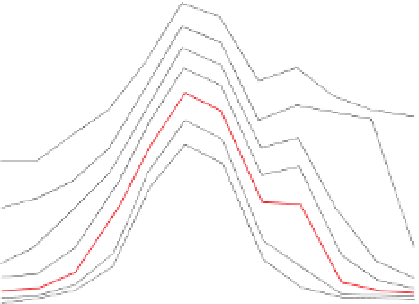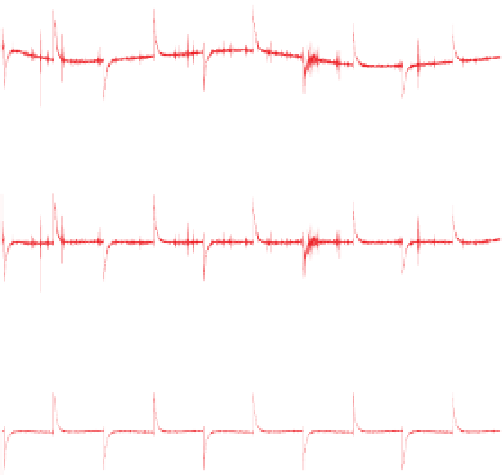Geoscience Reference
In-Depth Information
1
V
+
a)
10
3
0
50
Milliseconds
-
Ch1
Observed
data
10
2
Ch2
Ch3
Ch4
Ch5
Long-wavelength
noise component
10
1
Ch6
Data
after removing
long-wavelength
noise
0
10,000
10,200
10,400
Short-wavelength
noise component
Location (m)
b)
Data after
removing
both long- and
short-wavelength
noise
Total magnetic
intensity
(nT)
Gravity
(gu)
50,400
26
24
22
20
18
50,300
Magnetics
Figure 2.28
Removal of noise from SPECTREM airborne
electromagnetic data to resolve the transient decays using a
variety of
50,200
Gravity
50,100
Massive sulphide
mineralisation
10,000
10,200
10,400
The enhanced data are obtained from a series of filtering
operations, each treating the data in a different way. This is a
common strategy when working with geophysical datasets.
Some other common combinations of
Location (m)
c)
Resistivity ( m)
n
=1
140
60
20
200
filters are gradient
170
300
n
=2
76
44
300
500
130
83
filtering of gravity and magnetic data followed by low-pass
filtering to remove the short-wavelength noise enhanced by
the gradient computation, and migration of seismic data
remove the high-frequency noise that may result.
240
n
=3
50
100
78
510
160
130
650
n
=4
65
70
410
400
n
=5
91
270
670
570
191
740
n
=6
Pseudo-depth
140
370
Figure 2.29
Various pro
le plots of geophysical data from the
-
-
-
Thalanga massive Zn
Ag sulphide deposit, Charters Towers,
Queensland, Australia. (a) Electromagnetic data. The various curves
represent the multichannel measurements of the electromagnetic
response at increasing times (channels) after transmitter turn-off. (b)
Gravity and magnetic data. (c) Electrical resistivity pseudosection.
The vertical scale n represents the separation between the source and
receiver located at the surface (see
Section 5.6.6.3
) and is an
indication of the depth influencing the measurement. Based on
Pb
Cu
2.8
Data display
A variety of techniques are available for displaying 1D and
2D geophysical data, with the different forms of display
emphasising different characteristics of the data. The choice
of display should be made according to the objective of the
interpretation, in particular targeting versus geological map-
ping. The quality of the data is also important, as some forms
of display can be an effective means of suppressing noise.
respectively. Vertical scales are typically linear or logarith-
mic, the later providing amplitude scaling (see Amplitude
scaling in
Section 2.7.4.4
). Often several types of data
are available at each survey location; these may be multi-
parameter measurements or data from different surveys,
and they are plotted together to allow integrated interpret-
ation. Profiles are a simple, accurate and effective way
to display 1D data (
Figs. 2.29a
and
b
). The most common
2.8.1
Types of data presentation
The simplest form of data presentation is a 1D pro
le plot
displaying the variation of a parameter as a function of
distance along a survey traverse, or as a function of time or
frequency for a time- or frequency-based parameter,












































































































Search WWH ::

Custom Search